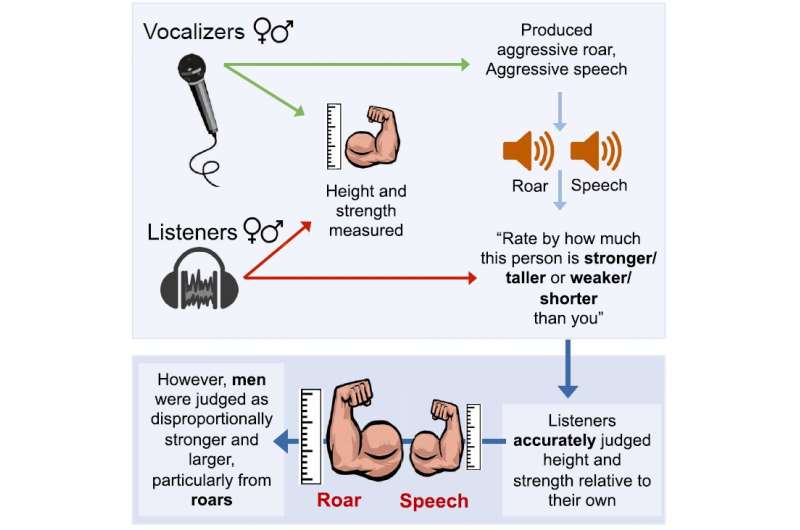I am human, hear me roar: Judging formidability from human vocalizations

Many animals—including sea lions, red deer, and dogs—use vocalizations to judge one another's size and physical formidability when in competition for mates or other resources. Now, researchers reporting in the journal iScience on June 28 have found that humans can use nonverbal vocal cues, including aggressive roars, in a similar way. The new evidence is the first to show that, from a vocalization alone, human listeners can estimate whether another person is stronger or weaker or taller or shorter than they are with a high degree of accuracy.
"Previous investigations have found that humans can estimate height and strength from the voice, but that they don't do it very well," said Jordan Raine of David Reby's vocal communication lab at the University of Sussex. "However, no one has ever investigated to what extent people can judge whether someone is stronger or weaker than themselves—a judgment that may be more relevant to the survival of our ancestors than judging someone's absolute strength or body size"
To find out what humans could infer from nonverbal vocal cues, the researchers measured the upper-body strength and height of men and women and recorded them producing aggressive roars and aggressive speech sentences. In two separate playback experiments, they then measured the upper-body strength and height of listeners and asked them to judge, based on those recordings, whether the vocalizer they heard was either stronger or weaker or taller or shorter than them.
And, indeed, they could. For example, when judging roars, male listeners accurately identified vocalizers who were substantially stronger than themselves in 88% of trials, and never as weaker.
Interestingly, listeners perceived male vocalizers as stronger when rating roars than when rating aggressive speech produced by the same person. Thus, the researchers say, roars serve to exaggerate the perceived strength of a male vocalizer.
The researchers also found that women tended to overestimate men's strength. When a male vocalizer was of similar strength or weaker than a female listener, women tended to rate the man as stronger. Raine says this finding is in keeping with a general tendency for women to underestimate, and men to overestimate, their abilities.
"When other animals produce vocalizations, they're doing so for a reason—they're communicating information about themselves, be it physical condition or internal state. The information is often 'honest,' but as our study shows, vocalizations can also serve to exaggerate traits such as physical formidability," Raine said. "Humans are unique in being able to express complex concepts and emotions with speech, but we still produce a wide range of nonverbal vocalizations, and our results suggest that these sounds communicate information in a similar way to other mammals. So, when you next hear a roar in a Game of Thrones battle scene, remember that it's more than just a noise—it is both a window into that person's physical characteristics and a social tool to influence those within earshot."
As for the researchers, they're continuing to investigate the acoustic structure and function of other human nonverbal vocalizations, including pain cries.
More information: iScience, Raine et al.: "Human listeners can accurately judge formidability relative to self from aggressive roars and speech" www.cell.com/iscience/fulltext … 2589-0042(18)30057-9 , DOI: 10.1016/j.isci.2018.05.002
Provided by Cell Press





















